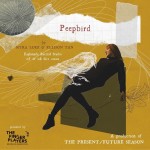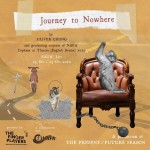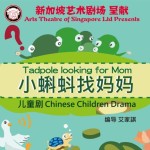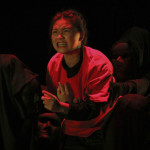“Between Devil and the Deep Blue Sea: From stage to screen”
Writer: Teo Xiao Ting
Performance: 6 November 2020
Sitting at home, viewing the livestream recording of Between Devil and the Deep Blue Sea after witnessing it live just two days before gave me an uncanny sense of displacement. An acute sense of flittering between two worlds: one constrained by the rectangular glow of my laptop screen, and the other sprawling free in the material world. I remember clearly details of the set, the disorientation catalysed by the performance’s intensity, and warm presence of other people sharing the space with me, as I viewed the livestream recording. Because I have had the privilege of witnessing both versions of the performance so close in time, its differences are made all the starker.
The last production project before students of NAFA’s Diploma in Theatre graduate, Devil was first staged in 2004, after The Finger Players’ first artistic overhaul. It is fitting, then, that this performance came at a time of re-examining the past to find a way towards the future, as part of TFP’s Present/Future season.
For an hour, I follow characters with generic names such as Man, Wife, Woman and Girl as the Devil haunts them. Nameless, with descriptive identities printed in plain text on t-shirts, it seems that they are meant to be caricatures of everyday people in Singapore. The Devil, too, expands into an ensemble of demons that hover and pull at the characters as they move through different circumstances and narrative scenes. Spaces within the set are clearly demarcated by white tape on the ground, mimicking the floorplan of a three-room HDB flat. The set is sparse and simple, filled with props made of cardboard, labelled the way Devil’s characters are – with plain text labels. This simplicity simultaneously brings Devil further into a space of abstraction, and also firmly roots it in reality. The characters could be anyone of us, living out lives anywhere in Singapore.
Devil opens with two Men (Linus Lim and Dzulkarnaen Djohan) mirroring each other’s movements as they wash up before a sink. What follows is a cacophony of noises we typically hear in a HDB corridor—a Woman rushing through the narrow hallways shouting that she is late, a Girl who is protesting against taking the ‘O’ level examinations, and the karang guni Man yelling for recyclables. The chaos ends only when a Grandmother, incensed, throws everyone who is screaming offstage, one by one.
The synchronicity set up by the two Men extends beyond the opening sequence — the cast is split into two permutations, each echoing the same lines. In Act One for example, on one side of the stage, we see a grandmother trying to convince her grandson to stay in Singapore, while on the other side of the stage, another grandmother and grandson pair have the exact same conversation. The repetition carries through to the other two acts, with two sets of the same family in each act.
There is some variation in language, such as how each grandson addresses his grandmother either as Ah Ma (Winnie Ng) or Patti (Hannah Sonia). There are also subtle differences in tone between the two sets of characters. For example, when one Man (Lim) retorts that he would sooner buy a coffin for his grandmother, the cruel edge of his voice cuts through the cold of the theatre. On the flipside, the other Man (Djohan), with a slightly softer intonation, made the same words sound more like a cheeky, albeit disrespectful, response.
Where the replicating sets of performances happens onstage in front of my eyes in the live performance, the livestream video frames each set separately, cutting between the two consecutively. The former experience let me feel the dread of an inescapable pattern in the lives of the characters, while the latter invited comparison, making clearer the differences between the two sets. Therein lies a fundamental difference in the two experiences: the live version feels to be a cohesive tapestry, while the livestream video makes the play feel unnervingly fragmented.
Perhaps this is the crux of what exactly gives way in a translation from stage to screen. Where live performance demands my entire body to be present as I witness the happenings that are unfolding in front of me, a recording encased in a screen makes for a more dissonant experience. We are still in the thick of grappling with the loss of what we know theatre to be, and part of the grief is a desire to return to a time where the loss had yet to occur.
I am currently training to be a counsellor. During my course, I was introduced to a technique called the “miracle question”. Like how it sounds, it’s a pivoting question that allows one to shift their thoughts towards the speculative, the what-if of how things are. In the case of theatre, perhaps the miracle question would be a complete return of theatre in its pre-pandemic form, or even to approach a semblance of its former self.
But as my course lecturer gently reminds me, the miracle question cannot slip into the delusional. For us, we cannot leave out a world that has been irrevocably changed by COVID-19.
What seems to be more reasonable is to ask how the magic of theatre can translate from stage to screen, without unfairly comparing the two. How can we allow the effervescence of collaboration, of sharing a stage or screen with another, to show up in different but no less concrete ways? I have no clear answer, but as the image of both Grandmothers in Devil glows in front of me, waving goodbye to both their grandsons and the audience at the edge of the stage, I think to myself that maybe this is not the time for answers, that it is okay to be in suspension as we continue to grapple with this time.
Do you have an opinion or comment about this post? Email us at info@centre42.sg.
ABOUT THE PRODUCTION
BETWEEN THE DEVIL AND THE DEEP BLUE SEA by The Finger Players
6 – 8 November 2020
Part of The Present/Future Season 2020
NAFA Studio Theatre | Sistic Live
ABOUT THE WRITER
Xiao Ting recently graduated from Yale-NUS College with a major in Arts & Humanities and a minor in Psychology. Her writing practice started with poetry, and has since moved towards a sort of explicit response. She’s still feeling out the contours of a “reviewer”, and thinks that each review is actually an act of love that documents and critically engages with performance.
This article is part of the C42 Documents: The Present/Future Season series.
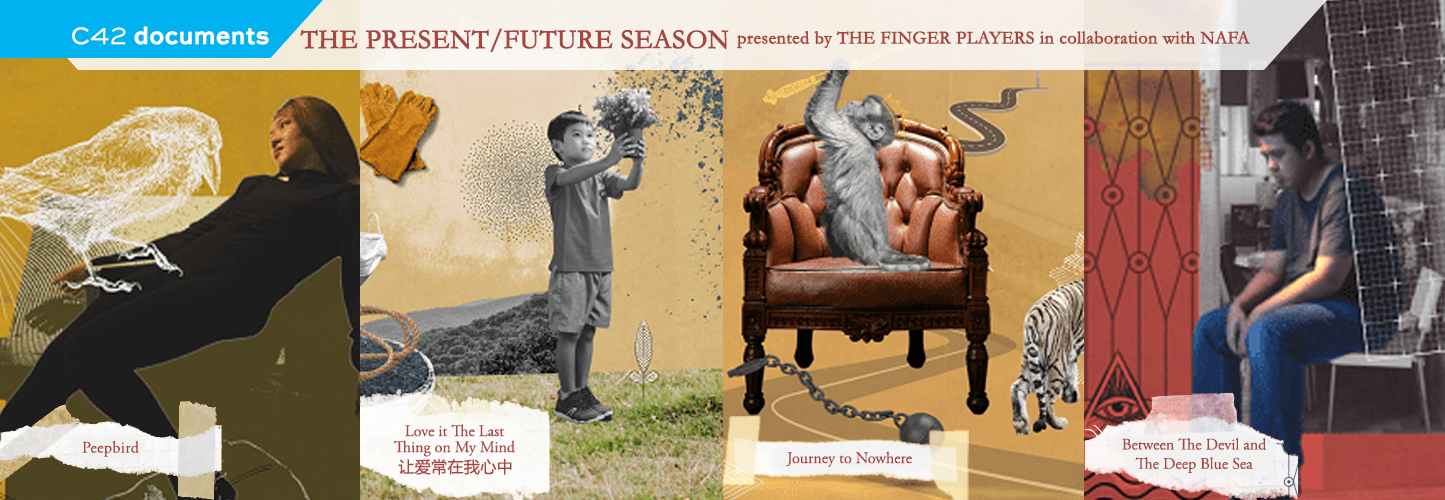
Centre 42 documents the creation process performances of the four productions in The Finger Player’s (TFP) The Present/Future Season. This documentation partnership with TFP aims to capture the inner workings of staging a production, illuminate the working relationships between practitioners and students, and create a textual record of the performance. Each production is documented by two writers, one focused on the performance-making process, and the other on the performance itself. The Present/Future Season was presented by TFP in collaboration with Nanyang Academy of Fine Arts (NAFA), and ran from 7 Oct to 8 Nov 2020.
C42 Documents: The Present/Future Season
[Process] Of First Flights and Transformations: Documenting “Peepbird”
[Process] What is Love?: Documenting “Love is the Last Thing On My Mind”
[Process] The Art of the Seamless Transition: Documenting “Between the Devil and the Deep Blue Sea”
[Performance] “Peepbird”: Decay and transformation
[Performance] “Journey to Nowhere”: Subversive, political take on a renowned classic tale
[Performance] “Love Is the Last Thing on my Mind”: Simple, poignant reminder to love”
[Performance] “Between Devil and the Deep Blue Sea”: From stage to screen

